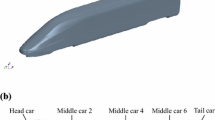Abstract
The global trend in the railway industry is the effort to increase the maximum speed and stability of a train. For an electric railway vehicle to meet this driving performance, stable electric power should be supplied by a catenary system. Various factors affect the current collection performance, most important of which is the dynamic characteristics of a pantograph. In this paper, the sensitivity analysis and design optimization of a pantograph for a high-speed train were conducted using a finite element method. The dynamic catenarypantograph interaction was analyzed by using the commercial finite element analysis software, SAMCEF. The pantograph was modeled as a three degrees of freedom mass-spring-damper system, and the pre-sag of the contact and messenger wire due to gravity was implemented. The span data of a high-speed line was applied in the analysis model. And the dynamic characteristics of the pantograph model were obtained by a performance test. The reliability of the simulation model was verified by comparing the analysis contact force results with the test data. By simulation, the mean contact force and its standard deviation etc. were evaluated, and then sensitivity of the pantograph was analyzed. Based on the sensitivity analysis results, the specification of the pantograph was optimized. In the optimization process, response surface analysis and differential evolutionary algorithm were applied to define the regressive function and to determine the optimum values for stable current collection performance. Finally, the improvement of the current collection performance was verified by comparing the optimum specification results with the original specification.
Similar content being viewed by others
References
F. Rauter and J. Ambrosio, Contact model for the pantograph- catenary interaction, Journal of System Design and Dynamics, 1(3) (2007) 447–457.
J. W. Seo and T. W. Park, Dynamic analysis of a pantograph-catenary system using absolute nodal coordinates, Vehicle System Dynamics, 44(8) (2006) 615–630.
J. W. Seo and T. W. Park, Three-dimensional large deformation analysis of the multibody pantograph/catenary systems, Nonlinear Dynamics, 42 (2005) 199–215.
A. Alberto and J. Benet, A high performance tool for the simulation of the dynamic pantograph-catenary interaction, Mathematics and Computers in Simulation, 79 (2008) 652–667.
A. Collina and S. Bruni, Numerical simulation of pantograph-overhead equipment interaction, Vehicle System Dynamics, 38(4) (2002) 261–291.
Y. H. Cho, Numerical simulation of the dynamic responses of railway overhead contact lines to a moving pantograph, considering a nonlinear dropper, Journal of Sound and Vibration, 315 (2008) 433–454.
N. Zhou and W. Zhang, Investigation on dynamic performance and parameter optimization design of pantograph and catenary systems, Finite Elements in Analysis and Design, 47 (2011) 288–295.
J. W. Kim and H. C. Chae, State sensitivity analysis of the pantograph system for a high-speed rail vehicle considering span length and state uplift force, Journal of Sound and Vibration, 303 (2007) 405–427.
S. P. Jung and T. W. Park, Analysis of the current-collection performance of a high-speed train using finite element analysis method, Transactions of Korean Society of Mechanical Engineers A, 35(7) (2011) 827–833.
S. P. Jung and T. W. Park, A study on the optimization method for a multi-body system using the response surface analysis, Journal of Mechanical Science and Technology, 23 (2009) 950–953.
K. Price and R. Storn, Differential evolution: Numerical optimization made easy, Dr. Dobbs Journal (1997) 18–24.
Y. G. Kim and C. K. Park, Design optimization for suspension system of high speed train using neural network, JSME International Journal: series C, 46(2) (2003) 727–735.
J. S. Paik, Dynamic performance evaluation and parameter optimization of the current collection system for the high-speed vehicle, Dissertation, Inha University (2012).
European committee for electrotechnical standardization EN 50119:2001, Railway Applications-Fixed Installations-Electric Traction Overhead Contact Line (2001).
UIC Code 799 OR, Characteristic of a.c. overhead contact systems for high-speed lines worked at speeds of over 200 km/h (2002).
Author information
Authors and Affiliations
Corresponding author
Additional information
Recommended by Associate Editor Gang-Won Jang
Jin Hee Lee received his B.S degree in Mechanical Engineering from Ajou University in 2009. Currently he is a Ph.D. candidate at Ajou University in Suwon, Korea. Mr. Lee’s research interests are in the area of flexible multibody dynamic and computer aided engineering.
Tae Won Park received his B.S degree in Mechanical Engineering from Seoul National University. He then went on to receive his M.S. and Ph.D. degrees from the University of Iowa. Dr. Park is currently a Professor at the School of Mechanical Engineering at Ajou University in Suwon, Korea.
Rights and permissions
About this article
Cite this article
Lee, JH., Kim, YG., Paik, JS. et al. Performance evaluation and design optimization using differential evolutionary algorithm of the pantograph for the high-speed train. J Mech Sci Technol 26, 3253–3260 (2012). https://doi.org/10.1007/s12206-012-0833-5
Received:
Revised:
Accepted:
Published:
Issue Date:
DOI: https://doi.org/10.1007/s12206-012-0833-5




